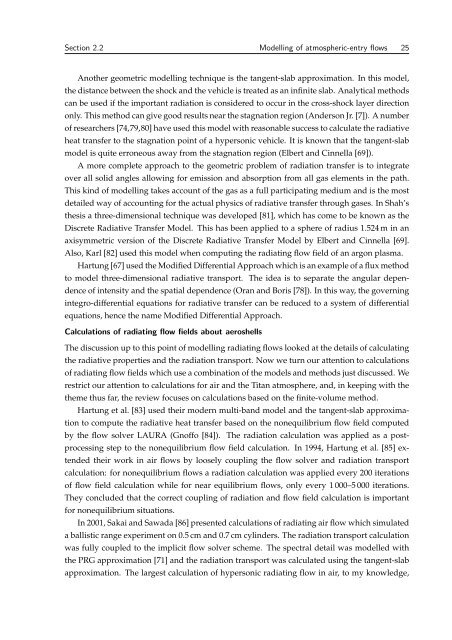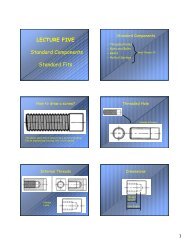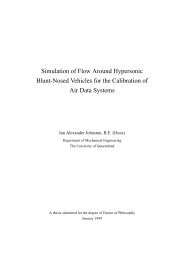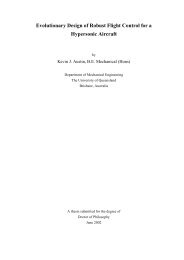Rowan-Gollan-PhD-Thesis - Mechanical Engineering - University of ...
Rowan-Gollan-PhD-Thesis - Mechanical Engineering - University of ...
Rowan-Gollan-PhD-Thesis - Mechanical Engineering - University of ...
Create successful ePaper yourself
Turn your PDF publications into a flip-book with our unique Google optimized e-Paper software.
Section 2.2 Modelling <strong>of</strong> atmospheric-entry flows 25<br />
Another geometric modelling technique is the tangent-slab approximation. In this model,<br />
the distance between the shock and the vehicle is treated as an infinite slab. Analytical methods<br />
can be used if the important radiation is considered to occur in the cross-shock layer direction<br />
only. This method can give good results near the stagnation region (Anderson Jr. [7]). A number<br />
<strong>of</strong> researchers [74,79,80] have used this model with reasonable success to calculate the radiative<br />
heat transfer to the stagnation point <strong>of</strong> a hypersonic vehicle. It is known that the tangent-slab<br />
model is quite erroneous away from the stagnation region (Elbert and Cinnella [69]).<br />
A more complete approach to the geometric problem <strong>of</strong> radiation transfer is to integrate<br />
over all solid angles allowing for emission and absorption from all gas elements in the path.<br />
This kind <strong>of</strong> modelling takes account <strong>of</strong> the gas as a full participating medium and is the most<br />
detailed way <strong>of</strong> accounting for the actual physics <strong>of</strong> radiative transfer through gases. In Shah’s<br />
thesis a three-dimensional technique was developed [81], which has come to be known as the<br />
Discrete Radiative Transfer Model. This has been applied to a sphere <strong>of</strong> radius 1.524 m in an<br />
axisymmetric version <strong>of</strong> the Discrete Radiative Transfer Model by Elbert and Cinnella [69].<br />
Also, Karl [82] used this model when computing the radiating flow field <strong>of</strong> an argon plasma.<br />
Hartung [67] used the Modified Differential Approach which is an example <strong>of</strong> a flux method<br />
to model three-dimensional radiative transport. The idea is to separate the angular depen-<br />
dence <strong>of</strong> intensity and the spatial dependence (Oran and Boris [78]). In this way, the governing<br />
integro-differential equations for radiative transfer can be reduced to a system <strong>of</strong> differential<br />
equations, hence the name Modified Differential Approach.<br />
Calculations <strong>of</strong> radiating flow fields about aeroshells<br />
The discussion up to this point <strong>of</strong> modelling radiating flows looked at the details <strong>of</strong> calculating<br />
the radiative properties and the radiation transport. Now we turn our attention to calculations<br />
<strong>of</strong> radiating flow fields which use a combination <strong>of</strong> the models and methods just discussed. We<br />
restrict our attention to calculations for air and the Titan atmosphere, and, in keeping with the<br />
theme thus far, the review focuses on calculations based on the finite-volume method.<br />
Hartung et al. [83] used their modern multi-band model and the tangent-slab approxima-<br />
tion to compute the radiative heat transfer based on the nonequilibrium flow field computed<br />
by the flow solver LAURA (Gn<strong>of</strong>fo [84]). The radiation calculation was applied as a post-<br />
processing step to the nonequilibrium flow field calculation. In 1994, Hartung et al. [85] ex-<br />
tended their work in air flows by loosely coupling the flow solver and radiation transport<br />
calculation: for nonequilibrium flows a radiation calculation was applied every 200 iterations<br />
<strong>of</strong> flow field calculation while for near equilibrium flows, only every 1 000–5 000 iterations.<br />
They concluded that the correct coupling <strong>of</strong> radiation and flow field calculation is important<br />
for nonequilibrium situations.<br />
In 2001, Sakai and Sawada [86] presented calculations <strong>of</strong> radiating air flow which simulated<br />
a ballistic range experiment on 0.5 cm and 0.7 cm cylinders. The radiation transport calculation<br />
was fully coupled to the implicit flow solver scheme. The spectral detail was modelled with<br />
the PRG approximation [71] and the radiation transport was calculated using the tangent-slab<br />
approximation. The largest calculation <strong>of</strong> hypersonic radiating flow in air, to my knowledge,







